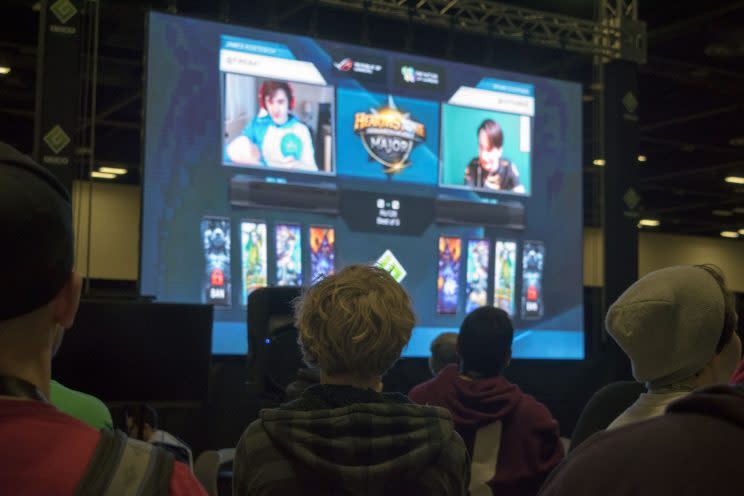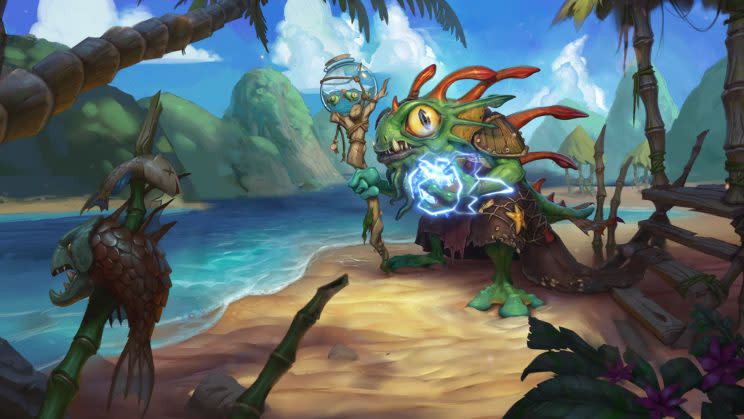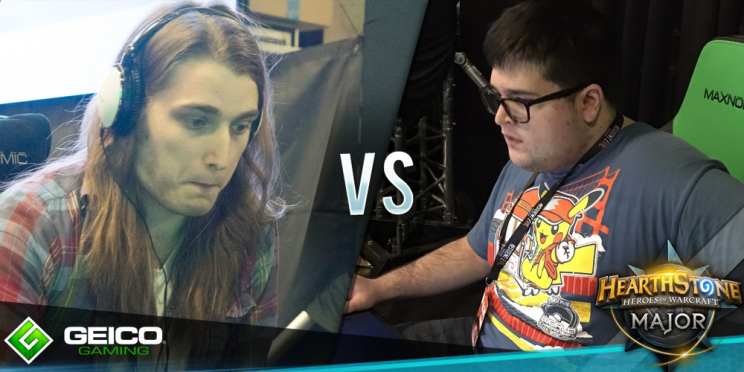Four things we learned from the PAX South Hearthstone Major

By Ozzie Mejia
PAX South was home to a Hearthstone Major hosted by One Nation of Gamers. One of the first major open tournaments to come along since the release of the Mean Streets of Gadgetzan expansion, the major was won by Frank “Leadpaint” Kissick, who swept Raymond “rayC” Cipoletti 3-0 in the finals.
For those who have spent the past few months grinding on the Hearthstone ladder, the pro meta looked familiar. But there were still some notable takeaways from the weekend’s matches.

Aggro Shaman is broken – and pros know it
Taylor Cocke recently examined the state of aggro decks and observed that the Aggro Shaman is the most devastating one currently in the game. Pro players appear to recognize that all too well, as just about every player entered in the Hearthstone Major carried one into battle. The Shaman was frequently banned, with James “Firebat” Kostesich joking at the start of the weekend, “It is busted, has been that way for about seven expansions.”
What precisely makes the Aggro Shaman so broken? It’s a combination of several newer cards. Small-Time Buccaneer is an incredibly powerful 1-mana drop, especially since it’s almost always accompanied by Patches the Pirate. The Buccaneer is boosted from 1 Attack to 3 Attack easily with two cheaper Shaman weapons: Spirit Claws and Jade Claws. The former gets a similar boost with the drop of a Wrath of Air Totem or Bloodmage Thalnos. And if the minions aren’t dealt with quickly, Flametongue Totem will boost them even more. Early removal is also a cheap option, thanks to Maelstrom Portal and Lightning Storm.
Given that all of these options are low-cost, powerful, and strike quickly, it’s no wonder that pros decided to scratch it off the board immediately. In fact, Shaman was banned on both sides for grand finals.
Pirate Warrior rules (but Reno Jackson looms)
What about the other main aggro option in the current meta? Warrior didn’t see as many bans as Shaman, which opened the door for Pirate Warrior to make frequent appearances over the course of the weekend – including the final game of the major, where it was used by both players. The punishing combination of Small-Time Buccaneer, Patches the Pirate, N’Zoth’s First Mate, Bloodsail Cultist, and Warrior’s hard-hitting weapons is often difficult to overcome.
“There’s statistical evidence to say [Pirate Warrior ban] is something that maybe you should look into in the current Conquest meta, because of how it lines up against a deck like Rogue,” observed Brian “Th3 Rat” Courtade at the start of the major.
Cong “StrifeCro” Shu, Terrence “TerrenceM” Miller, and rayC were among the players doing quick work with Pirate Warrior, polishing off opponents as early as turn 5. Rogues, Priests, and Paladins all fell to the pirate rush.
But Mage and Warlock decks running Reno Jackson proved capable of withstanding the keelhauling, mainly because of their wide selection of removal spells and healing minions like Mistress of Mixtures and Refreshment Vendor. Even an early Kazakus play would fall perfectly into the Reno player’s curve, with a 5-mana spell clearing the board, increasing armor, or both. By the time the Reno turn would come around, the Pirate Warrior player’s resources would be exhausted and their hand would be empty with no draw options. This happened in the second game of the finals, with Leadpaint’s Reno Mage out-resourcing rayC’s Pirate Warrior.
Some players managed to overcome Reno decks, though. Runner-up rayC beat David “JustSaiyan” Shan and William “Amnesiac” Barton’s Renolock decks with the help of Frothing Berserker, while StrifeCro outlasted Jeffrey “Trump” Shih’s Reno Mage.

Miracle Rogue is still hanging tough
Before the introduction of Mean Streets of Gadgetzan, the Miracle Rogue archetype had found its way back into the pro meta. Even with Gadgetzan Auctioneer nerfed to 6 mana, it has still proven to be an incredible value for Rogue players with cheap spells like Backstab, Conceal, and Preparation. Even with the introduction of new cards and the Jade Golem mechanic, Miracle Rogue is still hanging around in the pro game.
Several Miracle Rogues made appearances at the Hearthstone Major, built around perennial powerhouses like Edwin VanCleef and Questing Adventurer, both of which are massively bolstered by Rogue’s cheap spells. If anything, the archetype has become stronger with the addition of Counterfeit Coin, a 0-mana way to trigger Edwin, Questing, and Auctioneer. rayC demonstrated this in his round of 16 match with JustSaiyan, where he used cheap spells to build up 12/8 and 4/4 Questing Adventurers simultaneously, alongside an Auctioneer.
However, the future viability of Miracle Rogue may be something to keep an eye on as Hearthstone moves to its new Standard season. The same way the removal of Reno Jackson and Brann Bronzebeard threaten to wreak havoc on Renolock and Freeze Mage decks, Rogue players may soon despair at the loss of Tomb Pillager, which not only puts a 5/4 body on the board for 4-mana, but gives the Rogue an extra Coin to trigger the aforementioned minions’ effects. Tomb Pillager is the unheralded rock of the Miracle Rogue deck and it’ll be interesting to see what happens when he disappears from the meta.
Mage proves a worthy Kazakus disciple
Kazakus is a truly versatile legendary, providing spells for just about every need. The Kazakus spells are good for boosting armor against aggro decks, clearing the board against zoo players (especially when combined with Dirty Rat), or card draws whenever needed. Just about every Mage deck at the Hearthstone Major included Kazakus and it was often used later in the game in conjunction with Brann Bronzebeard.
Kazakus can be played early in a pinch to provide protection against pesky aggro decks, with 5-mana spells able to provide both control and an armor boost. This also makes him invaluable in marathon sessions against classes like Warlock and Priest. Brann allows for the flexibility of rolling the dice on a 10-mana spell, which Leadpaint was able to do in his semifinal match against Trump, the game where the eventual champion responded to a board full of minions with a spell that reduced them all to sheep.
Ozzie is on Twitter @Ozz_Mejia

